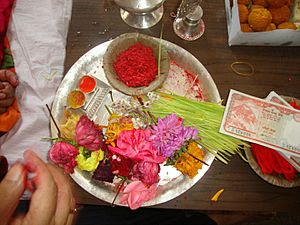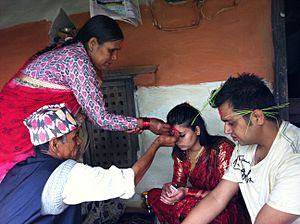Dashain facts for kids
Dashain is a very important festival that comes from Nepal. It is celebrated by Hindu people in Nepal. People of Nepali origin living in places like Sikkim, Assam, and the Darjeeling district of India also celebrate it. Even Lhotshampa people in Bhutan and Burmese Gurkhas in Myanmar join in the celebrations.
Dashain is the longest festival in the Nepali calendar, lasting for 15 days! The first, seventh, eighth, ninth, tenth, and fifteenth days are the most special. Many people consider it the biggest and most important festival in Nepal. It usually happens in September or October. The festival starts when the moon begins to get brighter in the month of Ashwin and ends on the full moon day (Purnima). Dashain is a symbol of the victory of good over evil.
Contents
What is Dashain?
Dashain is a time for families to come together and celebrate. It's a festival that honors the goddess Durga. People believe that during this time, good triumphs over bad. It's a joyful period filled with special rituals, delicious food, and fun activities.
When Does Dashain Happen?
Dashain is celebrated in the autumn season. It usually falls in September or October, depending on the lunar calendar. The dates change each year because it follows the Bikram Sambat calendar. The festival lasts for 15 days, but the main celebrations happen on specific days.
Important Days of Dashain
- Day 1: Ghatasthapana - This is the first day of Dashain. People plant barley seeds in a special pot. These seeds will grow into yellow shoots called Jamara, which are used later in the festival.
- Day 7: Fulpati - On this day, a special kalash (a pot of holy water) and flowers are brought from Gorkha, the birthplace of Nepal's former royal family. This marks the start of more intense celebrations.
- Day 8: Maha Ashtami - This day is dedicated to the goddess Kali, a powerful form of Durga. Many people offer sacrifices to the goddess.
- Day 9: Maha Navami - This is the last day of Navaratri (the nine nights of Durga worship). People worship tools, vehicles, and machinery, believing that the goddess blesses them.
- Day 10: Vijaya Dashami - This is the most important day! Elders put a special red mark called Tika on the foreheads of younger family members. They also give Jamara and blessings for good health and success.
- Day 15: Kojagrat Purnima - This is the full moon day and the last day of Dashain. People worship the goddess Laxmi, who brings wealth and good fortune.
How is Dashain Celebrated?
Dashain is a time for family reunions and traditions. People travel long distances to be with their loved ones. Homes are cleaned and decorated, and new clothes are bought.
Family Gatherings and Blessings
One of the most important parts of Dashain is receiving blessings from elders. On Vijaya Dashami, younger family members visit their elders. The elders apply Tika (a mix of rice, yogurt, and vermilion) and Jamara (the yellow barley shoots) on their foreheads. They also give blessings and sometimes money as gifts.
Food and Fun
During Dashain, families prepare many delicious traditional foods. Special dishes like Sel Roti (a sweet, ring-shaped bread) and various meat dishes are common. People also enjoy playing games and flying kites. Traditional bamboo swings, called 'ping', are set up in many villages for everyone to enjoy.
Why is Dashain Important?
Dashain is more than just a festival; it's a celebration of culture, family, and faith. It brings people together and strengthens community bonds. The festival reminds everyone about the importance of good winning over evil and encourages positive values. It's a time for joy, renewal, and gratitude.
Images for kids
See also
 In Spanish: Dasain para niños
In Spanish: Dasain para niños








